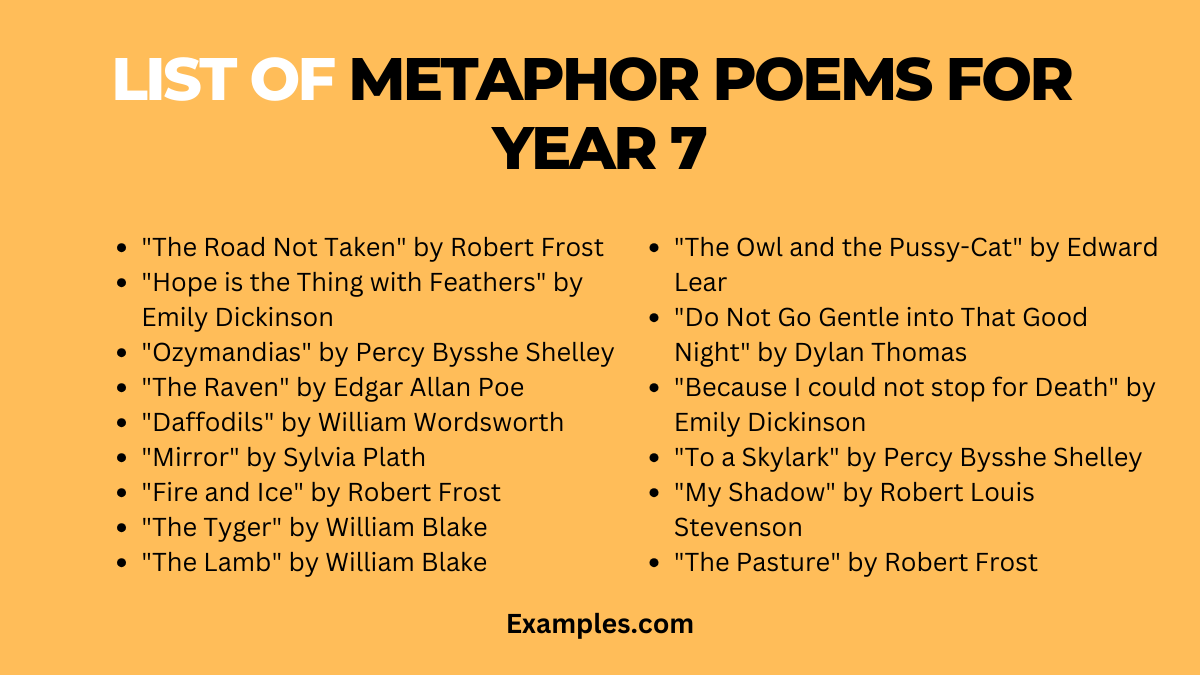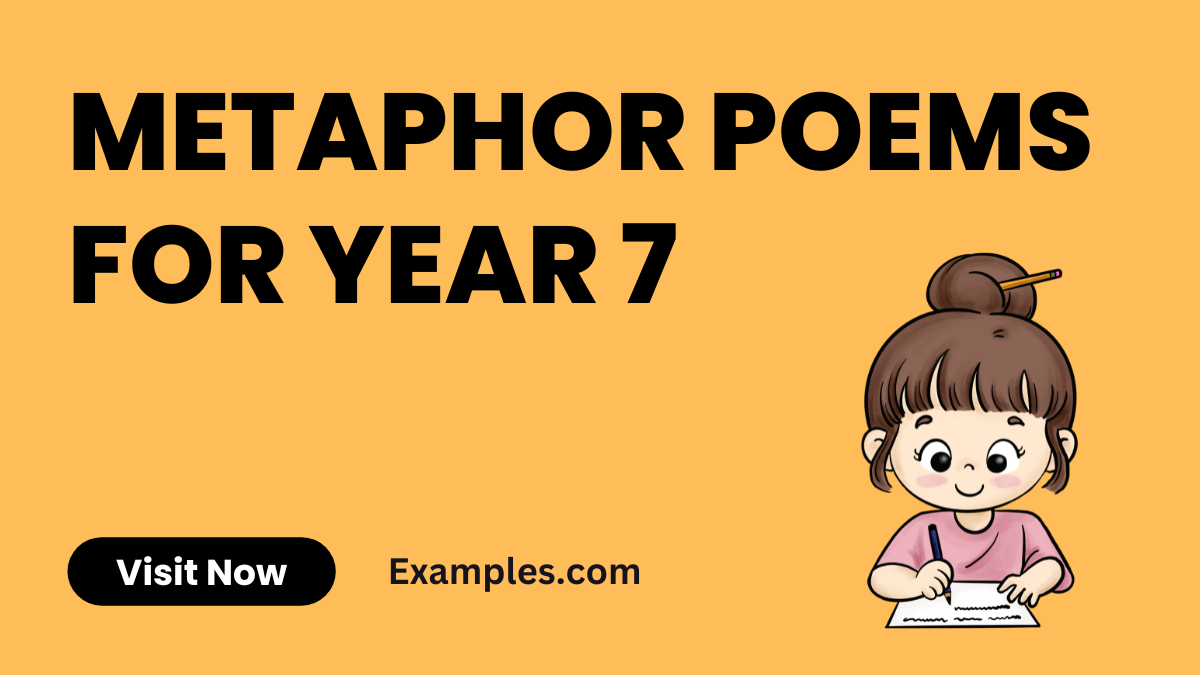14+ Metaphor Poems for Year 7 Examples
Dive into the captivating world of metaphor poems for Year 7 with our complete guide! Packed with vivid and inspiring Metaphor Examples, this resource is a treasure trove for both students and educators. Our guide not only offers a diverse range of poems that brilliantly illustrate the use of metaphors but also provides practical tips and insights. Whether it’s for enhancing creative writing skills or understanding complex poetic concepts, these examples make learning both fun and profound.
Download Metaphor Poems for Year 7 PDF
What is the Best Example of Metaphor Poems for Year 7?

One of the best examples of metaphor poems for Year 7 is Robert Frost’s “The Road Not Taken.” In this poem, the metaphor of a forked road represents life’s choices and their consequences. Frost beautifully captures the essence of decision-making and its impact on our lives, making it an ideal poem for Year 7 students to explore and understand the depth and power of metaphors in poetry. Metaphorical Phrases and Metaphorical Poems are key tools in the realm of literature, particularly in the education of young minds.
List of Metaphor Poems for Year 7

1. “The Road Not Taken” by Robert Frost
A 1916 poem reflecting on life’s choices, using paths as metaphors. Ideal for Year 7, it teaches decision-making and consequence. The poem’s simplicity, a classic among metaphor poems about love and life, is often used to teach metaphors in literature/literary contexts in schools often used to teach metaphors in schools. coupled with its deep metaphorical meaning, makes it a staple in literature classes.
Download Full Poem The Road Not Taken PDF
Metaphors:
- “Two roads diverged” – Opening Line: Life’s choices.
- “Yellow wood” – Line 1: Opportunities and uncertainties.
- “The road less traveled” – Final Stanza: Non-conformity and its impact.
2. “Hope is the Thing with Feathers” by Emily Dickinson
Dickinson’s poem, circa 1861, personifies hope as a bird. Great for Year 7, it makes abstract concepts tangible. This poem, suitable for metaphor poems for 3rd grade to 6th grade, uses simple language to convey a deep message about hope, much like metaphor sentence examples.
Download Full Poem Hope is the Thing with Feathers PDF
Metaphors:
- “Feathers” – Opening Line: Lightness and resilience of hope.
- “Sings” – Line 3: The uplifting nature of hope.
- “Storm” – Line 4: Life’s challenges.
3. “Ozymandias” by Percy Bysshe Shelley
Shelley’s 1818 poem uses a ruined statue as a metaphor for fleeting power, an excellent Extended Metaphor, uses a ruined statue to illustrate fleeting power. This poem is a significant resource for Metaphor Poems for Grade 7, aiding in discussions about historical and philosophical themes.
Download Full Poem Ozymandias PDF
Metaphors:
- “Stone legs” – Line 2: Ephemeral human achievements.
- “Shattered visage” – Line 4: The decay of power.
- “Sands” – Final Line: Time’s ability to erase human endeavors.
4. “The Raven” by Edgar Allan Poe
Poe’s 1845 narrative poem uses a raven with its use of a raven as a symbol of mourning and despair, stands as a prime Poem with Metaphor for Year 7 students. It provides a profound exploration of complex themes, making it ideal for teaching Metaphor Poems for Year 7.
Download Full Poem The Raven PDF
Metaphors:
- “Raven” – Throughout: Unending grief.
- “Midnight” – Line 7: Darkness of sorrow.
- “Shadow” – Final Line: Lingering presence of loss.
5. “Daffodils” by William Wordsworth
Wordsworth’s 1807 poem celebrates the beauty of nature with daffodils as metaphors for joy and beauty, serves as an inspirational tool for teaching Metaphor Poems About Love and happiness.
Download Full Poem Daffodils PDF
Metaphors:
- “Dancing daffodils” – Line 6: Joyfulness.
- “Stars” – Line 7: Vastness and wonder.
- “Continuous as the stars” – Line 9: Infinite beauty.
6. “Mirror” by Sylvia Plath
Plath’s 1961 poem explores exploring themes of identity, aging, and truth through the metaphor of a mirror, offers deep insights for Metaphor for Schools. Suitable for Year 7, it encourages students to ponder over deeper themes, making it a valuable teaching resource for Metaphor for Teaching.
Metaphors:
- “Silver” – Line 1: Clarity and reflection.
- “Lake” – Line 10: Depth and introspection.
- “Drowned girl” – Line 17: Changes over time.
7. “Fire and Ice” by Robert Frost
Frost’s 1920 poem metaphorically discusses human emotions and their destructive potential, making it a thoughtful read for Year 7 students. It exemplifies Easy Metaphor while conveying profound ideas, making it an essential piece for Metaphor Poems for 7th Grade.
Metaphors:
- “Fire” – Line 1: Desire and passion.
- “Ice” – Line 2: Hatred and indifference.
- “World end” – Line 4: The finality of extreme emotions.
8. “The Tyger” by William Blake
Blake’s 1794 poem, from “Songs of Experience,” delves into nature and creation through a tiger metaphor, prompting deep thought in Year 7 students.
Metaphors:
- “Tyger” – Throughout: Nature’s ferocity and beauty.
- “Fire in thine eyes” – Line 6: Fierce energy.
- “Wings” – Line 7: The divine and mysterious.
9. “The Love Song of J. Alfred Prufrock” by T.S. Eliot
Eliot’s 1915 modernist poem offers an introspective journey, making it suitable for Year 7’s exploration of Metaphor Examples in Literature.
Metaphors:
- “Evening spread out against the sky” – Line 2: Overwhelm and anxiety.
- “Coffee spoons” – Line 51: Monotony of life.
- “Mermaids singing” – Line 125: Unattainable desires.
10. “The Lamb” by William Blake
Blake’s 1789 poem from “Songs of Innocence” uses a lamb as a metaphor for purity and gentleness, an accessible metaphor for Year 7. It’s a classic example of Implied Metaphor, making it a valuable piece for teaching young students about subtlety in poetry.
Metaphors:
- “Lamb” – Throughout: Innocence.
- “Softest clothing” – Line 2: Gentleness.
- “Tender voice” – Line 5: The soothing nature of innocence.
Famous Metaphor Poems for Year 7
1. “The Road Not Taken” by Robert Frost
A seminal work from 1916, Frost’s poem is a profound reflection on choices and paths in life, making it a crucial teaching tool for metaphor in Year 7.
Metaphors:
- “Two roads” – Opening Line: Different life paths.
- “Yellow wood” – Line 1: Life’s opportunities and uncertainties.
- “Less traveled road” – Closing Stanzas: The path of individuality and its consequences.
2. “Ozymandias” by Percy Bysshe Shelley
Shelley’s 1818 poem uses the ruins of a great statue as a metaphor for the impermanence of power, offering rich material for Year 7 students. Utilizing the ruins of a great statue as a metaphor for the impermanence of power, offers rich material for Metaphor for Kids.
Metaphors:
- “Stone legs” – Line 2: The remnants of past glory.
- “Shattered visage” – Line 4: The fallibility of human pride.
- “Lone and level sands” – Final Line: Time’s erasing of human achievements.
3. “The Raven” by Edgar Allan Poe
Poe’s 1845 narrative poem uses a raven to symbolize grief and loss, a perfect example for Year 7 students studying complex emotions. It’s a quintessential piece for discussing Metaphor in Daily Life, especially in the context of dealing with complex emotions like grief and loss.
Metaphors:
- “Raven” – Throughout: The unrelenting nature of grief.
- “Midnight” – Line 7: The depth of despair.
- “Shadow” – Line 108: The lasting impact of loss.
Short Metaphor Poems for Year 7
1. “Fog” by Carl Sandburg
Metaphors:
Sandburg’s 1916 short poem captures the essence of fog through metaphor, a great example for Year 7 students on descriptive imagery. It’s an excellent piece for teaching Simple Metaphor, showing how everyday phenomena can be turned into profound metaphorical expressions.
- “Little cat feet” – Line 1: The stealthy, quiet approach of fog.
- “Sits looking” – Line 2: Fog as an observer.
- “Moves on” – Final Line: Transience of natural phenomena.
2. “Fire and Ice” by Robert Frost
Frost’s 1920 poem discusses human emotions using fire and ice as metaphors, an accessible and thought-provoking piece for Year 7.
Metaphors:
- “Fire” – Line 1: Desire and passion.
- “Ice” – Line 2: Cold indifference and hate.
- “World end” – Line 4: The destructive power of emotions.
3. “This Is Just To Say” by William Carlos Williams
Williams’ 1934 poem is a masterful use of metaphor in everyday context, ideal for Year 7’s exploration of subtlety in poetry. This poem serves as a perfect example of Dead Metaphor, illustrating how everyday language can be enriched with metaphorical meanings.
Metaphors:
- “Plums” – Line 1: Temptation and forgiveness.
- “Icebox” – Line 2: Restraint and contemplation.
- “Delicious” – Line 3: The sweetness of forbidden pleasures.
Best Metaphor Poems for Year 7
1. “Still I Rise” by Maya Angelou
Angelou’s 1978 poem uses metaphors of nature and history to depict resilience, perfect for Year 7’s study of empowering poetry.
Metaphors:
- “Dust” – Line 4: Overcoming adversity.
- “Black ocean” – Line 33: Depth and strength of character.
- “Rising suns” – Line 40: Hope and new beginnings.
2. “The Love Song of J. Alfred Prufrock” by T.S. Eliot
Eliot’s 1915 poem is a rich tapestry of modernist metaphors, offering Year 7 students insights into complex emotional states.
Metaphors:
- “Evening spread out against the sky” – Line 2: Life’s overwhelming moments.
- “Coffee spoons” – Line 51: The monotony of existence.
- “Mermaids” – Line 125: Unfulfilled desires.
3. “The Tyger” by William Blake
Blake’s 1794 poem contemplates creation through the metaphor of a tiger, challenging Year 7 students to think deeply about nature and art. It serves as an exemplary piece for Metaphor in Semantics, demonstrating how language can be used to explore and convey intricate psychological landscapes.
Metaphors:
- “Tyger” – Throughout: Nature’s ferocity and mystery.
- “Fire in thine eyes” – Line 6: Intensity and vitality.
- “Wings” – Line 7: The sublime and spiritual.
In summary, these metaphor poems offer Year 7 students a diverse and enriching experience, illustrating the power of metaphors in expressing complex ideas and emotions. From Frost’s reflective paths to Angelou’s rising suns, each poem serves as a window into the depth and versatility of poetic language. This collection not only enhances students’ understanding of literary devices but also deepens their appreciation for the beauty and nuance of poetry.


